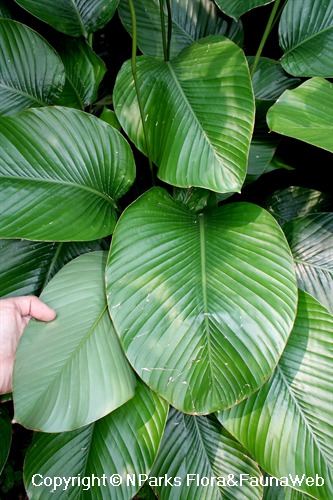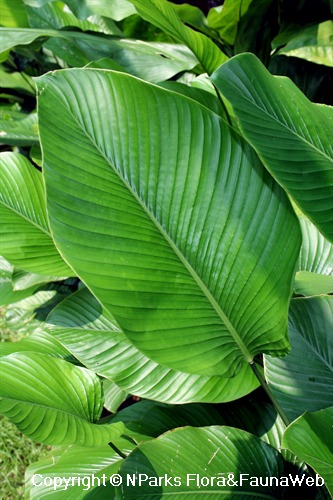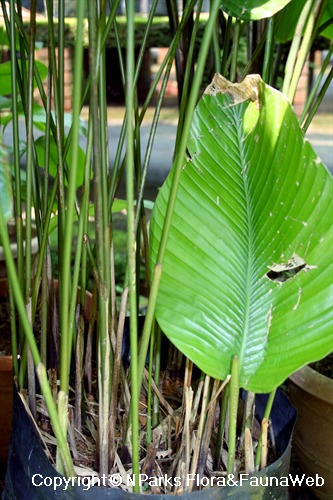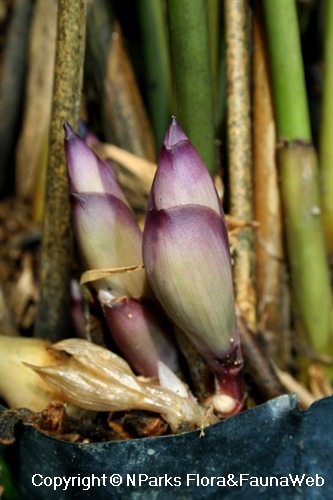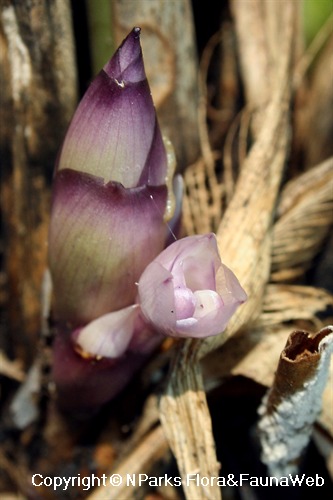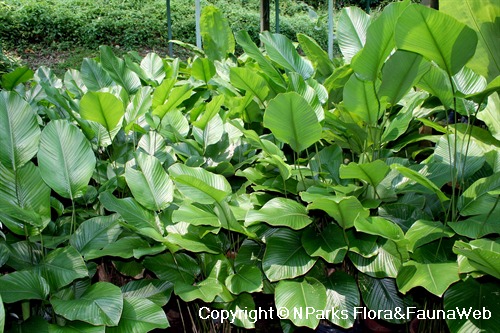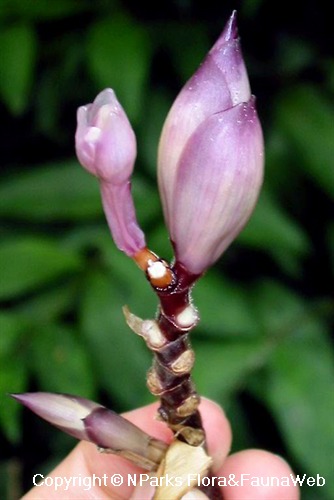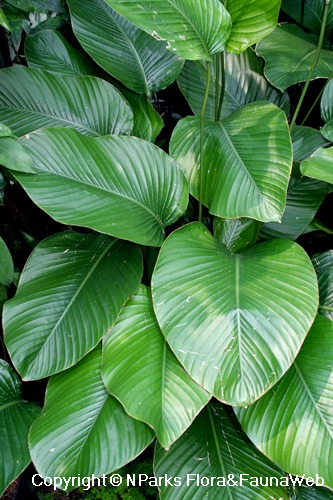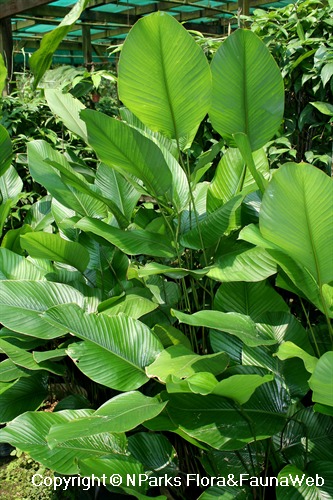
Back
Thaumatococcus daniellii (Benn.) Benth. ex B. D. Jacks.
| Family Name: | Marantaceae |
| Synonyms: | Monostiche daniellii, Donax danielii, Phrynium daniellii |
| Common Name: | Miracle Berry, Sweet Prayer Plant, African Serendipity Berry, Katempfe, Katamfe, Yoruba Soft Cane, Miracle Fruit |
Name
Classifications and Characteristics
| Plant Division | Angiosperms (Flowering Seed Plants) (Monocotyledon) |
|---|---|
| Plant Growth Form | Herbaceous Plant |
| Lifespan (in Singapore) | Perennial |
| Mode of Nutrition | Autotrophic |
| Maximum Height | 0.6 m to 4.0 m |
Biogeography
| Native Distribution | West Africa, Central Africa |
|---|---|
| Native Habitat | Terrestrial (Primary Rainforest) |
| Preferred Climate Zone | Tropical |
Description and Ethnobotany
| Growth Form | Herbaceous clumping shrub, growing up to 4m tall in ground. No apparent stems above ground surface, but has slender underground rhizomes. |
|---|---|
| Foliage | Leaves large and papery, held on thin but stiff petioles (leaf stalks), with numerous parallel lateral veins set at 45 degrees to the mid-vein. |
| Flowers | Pale purplish-pink, with up to 10-12 flowers clustered in simple or forked/ spiked purple inflorescences near base of plant. |
| Fruit | Fleshy berries, pyramidal or trigonal in shape, produced throughout the year at base of plant from 2-4 flowers per inflorescence, mature from dark green to brown and then bright red, containing 1-3 black seeds surrounded by transuclent gel-like, cream-coloured, sweet-tasting pulp. |
| Habitat | Found in forest understorey and forest clearings in native range. |
| Similar | When not flowering or fruiting. plant superficially resembles Calathea lutea, but latter's leaves are more silvery-white on the underside. Despite the very different physical appearances, plant is sometimes confused with the woody Synsepalum dulcificum (Miracle Fruit) or Sphenocentrum jollyanum, whose fruits and roots respectively have a similar sweetening effect. |
| Cultivation | Likes humidity and lots of water. Can take full sun, as long as sufficient water is provided. Propagate by division of plants and rhizomes, suckers or seeds. |
| Etymology | Genus epithet 'Thaumatococcus' derived from Greek words 'thaumato' (wondrous or miraculous) and 'kokkos' (berry). Species epithet 'daniellii' named in honour of British army surgeon and botanist, William Freeman Daniell (1818–1865), who led an expedition to Central Africa, and described indigenous uses of various African plants. |
| Ethnobotanical Uses | Edible Plant Parts : Edible Fruits Food (Herb or Spice) Others: Food: Fruit aril (skin) contains an intensely-sweet protein called thaumatin. Traditionally used to sweeten bread, as well as to improve the flavour of sour food and fermented palm wine. Thaumatin extracts (2,000-3,000 times sweeter than sucrose) widely used in confectionary, beverages, desserts, chewing gum, pet food and pharmaceutical products in Europe. Medicinal: Leaf sap used as antidote for poisonous stings and bites. Products: Leaves used to wrap food. Leaf petioles used to make tools and as building materials. |
Landscaping Features
| Desirable Plant Features | Ornamental Foliage, Ornamental Fruits |
|---|---|
| Landscape Uses | Interiorscape/ Indoor Plant, Container Planting, General |
| Thematic Landscaping | Economic Garden, Naturalistic Garden |
Plant Care and Propagation
| Light Preference | Semi-Shade, Full Sun |
|---|---|
| Water Preference | Moderate Water |
| Plant Growth Rate | Moderate |
| Rootzone Tolerance | Fertile Loamy Soils, Well-Drained Soils |
| Maintenance Requirements | Moderate |
| Propagation Method | Seed, Sucker, Division |
Foliar
| Foliage Retention | Evergreen |
|---|---|
| Mature Foliage Colour(s) | Green |
| Mature Foliage Texture(s) | Smooth, Papery, Raised / Sunken Veins, Thin |
| Foliar Type | Simple / Unifoliate |
| Foliar Shape(s) | Non-Palm Foliage (Ovate, Elliptical) |
| Foliar Venation | Parallel |
| Foliar Margin | Entire |
| Foliar Apex - Tip | Acuminate |
| Foliar Base | Truncate / Square |
| Typical Foliar Area | Macrophyll ( 182.25cm2 - 1640.25 cm2 ) |
| Leaf Area Index (LAI) for Green Plot Ratio | 3.5 (Shrub & Groundcover - Monocot) |
Non - Foliar and Storage
| Stem Type & Modification | Acaulescent |
|---|---|
| Root Type | Underground (Fibrous Root) |
| Specialised Storage Organ(s) | Underground (Rhizome) |
Floral (Angiosperm)
| Flower & Plant Sexuality | Bisexual Flowers |
| Flower Colour(s) | Pink, Purple, White |
|---|---|
| Flowering Habit | Polycarpic |
Fruit, Seed and Spore
| Mature Fruit Colour(s) | Red |
|---|---|
| Fruit Classification | Simple Fruit |
| Fruit Type | Fleshy Fruit , Berry |
Image Repository
Others
| Master ID | 1211 |
|---|---|
| Species ID | 2504 |
| Flora Disclaimer | The information in this website has been compiled from reliable sources, such as reference works on medicinal plants. It is not a substitute for medical advice or treatment and NParks does not purport to provide any medical advice. Readers should always consult his/her physician before using or consuming a plant for medicinal purposes. |

